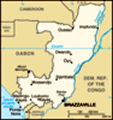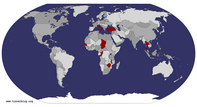Advertisement
Published: July 10th 2010
Bétou, Province Likouala, Congo
I had my doubts about coming here. I was already on the fence about the idea of continuing what my friends in the field and I have come to term The International Life. The International Life being the life of humanitarian workers, whose lives I have come to realize are wholly dictated by a love of the field and little else. First there are the obvious disadvantages: moving from place to place, the inability to maintain a home or a relationship, the distance from loved ones, goat cheese and baguettes…the list goes on. Then there are the downsides that we tend to ignore or suppress, such as the truly depressing nature and inherent frustrations of the work, the constant questioning of why on earth am I off in some forsaken place, and the bewilderment as to what exactly you are accomplishing. I had a lot of time to ponder these pros and cons before my departure; I was selected as a finalist for this position back in January, and wasn’t actually deployed until May because the office wasn’t even open until January and was in “emergency” status until April, when recruitment finally began. During that time
I had almost convinced myself that there isn’t enough about this profession that makes it worth the hardships. I have had the good fortune to have been deployed to “good” duty stations up to this point; Lilongwe is a capital city which, despite being expensive and somewhat high-risk for crime, was a very pleasant place to live (as though of you who read my blogs may know). My work as well as my social life was fuller than I could have wished for in the U.S. Mae Hong Son, despite its provincial nature, was a small city full of life and interesting people and delicious food. We complained about the lack of activities, expats and nightlife, but since leaving, I can’t really remember why. I guess it’s part of the phenomenon of always thinking the grass is greener elsewhere.
So when I was proposed a job in the most remote town in the most remote section of a country mostly associated with war and strife, I was less than thrilled. The work sounded extremely challenging, which is very important to me, but the more I researched about this town, the less I wanted to come. In fact, Googling the
name of my town garnered extremely limited information; I was able to find it on a map and see a lot of links related to the refugee crisis, but that’s about it. In May, when I was offered the job, I was put in touch with a colleague on the ground so she could tell me about living conditions. I was pleased to learn they had electricity and internet, and even air-con, and I can live with cold bucket showers and rice and fish every day. What worried me most was the isolation. I think I mostly pretended to struggle with the decision, though. In my heart I’m just too drawn to the work and the adventure. Sure, if I had been offered the same job somewhere in a capital city, I’d be tempted, but the challenges of living in the field are often what make it so exciting. The idea of sitting behind a desk somewhere just doesn't have the same appeal.
So, I flew here on a UN plane. This place is so inaccessible there isn’t any other way to get here. I’m in the middle of the second-largest forest in the world, on the edge of
a river that flows from Brazzaville (the capital) up to Bangui (the capital of Central African Rep.). All the refugees fled from small villages on the other side of the river to this side, and are scattered in impromptu settlements for about 150km down the shoreline. (See map if you’re curious.) There is one dirt road here, built for extracting timber, but it’s very slow going, especially in the rainy season (which just started around the time of my arrival). We took about 3 hours to go a distance of 20km, between the airstrip in Inyele and Bétou.
So…did I mention the UN plane? 😊 I can’t stop bragging about that, sorry but it was pretty amazing. First of all, our convoy of UNHCR vehicles drove straight onto the tarmac of Brazzaville’s international airport—we didn’t even have to stop at the checkpoint. We drove right past the huge jets lined up by the terminal! It was so wild. I was wondering which one was ours when we pulled up at this miniscule little propeller plane. Next to the 747s, it was a little bit of a letdown—easily forgotten after seeing the big ‘UN’ painted on the tail, and the
words 'Humanitarian Air Service' emblazoned along the side. Pardon my language, but I felt really bad-ass.
So there were people loading cargo into the cabin (there is no cargo hold), all boxes of sanitary napkins and some schoolbooks donated by the Ministry of Education. Four seats were reserved for us (and one crew member) out of about 20, the rest of the seats were loaded up with boxes and our luggage. We got actual plane tickets, which seemed funny so I kept mine. The UNHCR Representative, my new colleague Hashim (who was also newly arrived) and I sat in the front row, directly behind the pilot and first officer. After we sat down, the pilot (a very handsome, friendly South African) turned around and told us the flightplan and about wearing our seatbelts. No flight attendants, just the flight technician (East European) who sat behind us.
We first flew to Mbandaka, where there is a MONUC (UN peacekeeping mission in the Congo) base, for refueling. The city was attacked in April so there were UN planes and vehicles everywhere, and lots of Blue Helmets in full military gear who seemed to be from everywhere, maybe South America, maybe
South East Asia too. There was a container converted into bathrooms, and the waiting room even had cold drinks for sale. I got a bottle of water; I handed over $10 USD, and got back 6500 DRC francs. The bottle bore the label of a local company in Kinshasa, and proclaimed that the water was purified
avec la dernière technologie Américaine (the latest U.S. technology). For a silly split-second I thought that was reassuring… After taking off from Mbandaka there was nothing out the window but dense forest, and the occasional vein of red dirt road.
After an hour we started descending; suddenly we’re really close to the ground, and still no sign of a single structure, let alone runway, when bam, we touchdown and I see we are in fact landing
on one of those dirt roads. We bounce a few times and eventually stop at the end of the dirt road, which is lined with Pygmys* there to see the plane and the
mondele (white person) they know it to usually contain. Nothing around but trees; it was literally just a strip of dirt in the middle of the forest. Not a single building of any kind,

 Unloading the cargo in Inyele...
Unloading the cargo in Inyele...
...as villagers watch and the Rep. checks his Blackberry
just a few UNHCR vehicles to take us and the cargo to Bétou. I said goodbye to the pilot; he smiled and told me to enjoy my stay but all I could see in his face was, “Poor you” and “Thank God I only have to drop people off here.”
We drove north through the forest to Bétou, down a narrow, muddy dirt road that frequently required the driver to switch to 4x4 mode and apply various automotive maneuvers I can only guess at, like stopping the car and leaning down by the front tires. We passed nothing but the occasional Pygmy hut or small group of children peeking out from behind the vegetation to wave at us as we drove by.
We entered Bétou on a dirt road which I was informed is actually its non-functional airstrip. (The EU just sent a mission here to plan its refurbishment, which they’re going to pay for as part of their support of the humanitarian activities here.) We drove straight to the UNHCR base, which is a walled-in compound with an office wing and a residential wing. The offices are very very basic; they are identical to the offices we

 Driving from Inyele to Bétou
Driving from Inyele to Bétou
One of the better sections of road had in the camp in Malawi. But, we have internet and satellite communication.
I was brought to my room, which was basically one third of a shipping container (the other two thirds being occupied by my Norwegian colleague, Tordis, and our shared bathroom). It was TINY. (I have since upgraded to a full container, thankfully.) But I have air-con and electricity, and a pretty nice bathroom. It even has faucets and a shower head, though there is no running water 😱.
The residential wing has a little thatched-roof cabana (
la paillote) which serves as a lounge for the international staff (there are eight of us). It has a satellite TV with all kinds of French and African channels (and even CNN, though I never get to watch it since I’m the only Anglophone!). We eat all our meals together there, which are prepared by our local cooks, Christine and Virginie. Their repertoire is extremely limited, but they make up for it in kindness. We eat rice and fish cooked in a whole lot of palm oil and some tomato paste—every day. We also eat boiled cassava and boiled greens. Can you sense how thrilled I am? 😊 We

 Bétou’s “airstrip”
Bétou’s “airstrip”
(sorry this is blurry since I took it from inside the car)do get meat and fresh tomatoes every few weeks though, and we eat delicious fresh pineapple with every meal. And I had been forewarned, so I brought 4 boxes of imported goods from the supermarché in Brazzaville. Actually I think the cooks themselves aren’t thrilled by the lack of menu options—they asked me to teach them some new recipes.
So there’s my first week. I am skipping the part about the unbelievably bad luck I had while getting here (flight time changes turning a 9-hour layover into a 60-hour one, lost bags, getting mild food poisoning my first day here…). I’ve settled in and started going to the refugee sites, will tell you more about that next time.
xoxo Martina
*Pygmys are an ethnic minority who live in the forest in the Congos. They are totally marginalized and discriminated against by other ethnic groups and by the government, and as a result they suffer from exploitation and poor living conditions. They live in the most basic shelters I have ever seen, with little access to services for education, health, sanitation…
Advertisement
Tot: 0.441s; Tpl: 0.019s; cc: 19; qc: 117; dbt: 0.2556s; 1; m:domysql w:travelblog (10.17.0.13); sld: 1;
; mem: 1.4mb




















